challenges facing express delivery services in canada's urban centres
challenges facing express delivery services in canada's urban centres
challenges facing express delivery services in canada's urban centres
You also want an ePaper? Increase the reach of your titles
YUMPU automatically turns print PDFs into web optimized ePapers that Google loves.
Institute of Hous<strong>in</strong>g & Mobility<br />
Challenges <strong>fac<strong>in</strong>g</strong> couriers and same-day messengers <strong>in</strong> Canada<br />
INTRODUCTION<br />
Classical economic theory suggests that the three key factors of production are labour, land, and<br />
capital. These factors were deemed sufficient for produc<strong>in</strong>g goods and <strong>services</strong> until the<br />
emergence of communication and <strong>in</strong>formation technologies (CIT). The modern means of<br />
communication have changed the way bus<strong>in</strong>ess is be<strong>in</strong>g conducted. From telephone and telexes<br />
for most of the 20th century, faxes <strong>in</strong> the 80s, e-mail <strong>in</strong> the 90s, and web conferenc<strong>in</strong>g today,<br />
bus<strong>in</strong>esses have readily adopted a host of technologies to improve communication with various<br />
stakeholders.<br />
Despite the technological advances, there has been no shortage of demand for paper-based<br />
communications. The forecasts of paper-based communication becom<strong>in</strong>g obsolete after the<br />
emergence of e-mail have ultimately proven false. In fact, public and private sector couriers are<br />
carry<strong>in</strong>g more documents and packages today than they did before the emergence of e-mail.<br />
The fact rema<strong>in</strong>s that as economies and populations grow around the world, the volume of letters<br />
and parcels also <strong>in</strong>crease. Moreover, globalization and <strong>in</strong>tegration of economies, as well as<br />
advances <strong>in</strong> logistics, supply cha<strong>in</strong> management, and just-<strong>in</strong>-time <strong>delivery</strong> systems have also<br />
contributed to the growth <strong>in</strong> volume and distances traveled by letters and parcels. The efficient<br />
movement of these shipments depend on <strong>express</strong> <strong>delivery</strong> <strong>services</strong> (EDS), consist<strong>in</strong>g of courier and<br />
same-day <strong>delivery</strong> bus<strong>in</strong>esses.<br />
This report has been prepared for policymakers, media, and the general public to:<br />
1. document the scope and contribution of EDS to the Canadian economy,<br />
2. ascerta<strong>in</strong> potential impediments to efficient deliveries <strong>in</strong> <strong>urban</strong> cores,<br />
3. identify any conflicts between a city’s desires to promote bus<strong>in</strong>ess growth with regulation,<br />
policy, facilitation, and enforcement,<br />
4. review park<strong>in</strong>g regulation, adm<strong>in</strong>istration, enforcement, and penalties, and<br />
5. provide recommendations for practical short-term and longer-term solutions to <strong>urban</strong><br />
mobility <strong>challenges</strong> faced by EDS <strong>in</strong> Canada.<br />
Challenge<br />
While different tiers of governments have made significant efforts to ensure that bus<strong>in</strong>esses enjoy<br />
ready access to labour, the same has not been repeated for other necessary factors of<br />
production, such as letters and parcels. Massive <strong>in</strong>vestments <strong>in</strong> public transit systems and highways<br />
make it possible for millions of workers to commute to work each day. Subway and streetcar<br />
stops, bus stops and bus bays facilitate access to work dest<strong>in</strong>ations for millions of workers.<br />
While billions of dollars are rout<strong>in</strong>ely spent to create new transit <strong>services</strong> <strong>in</strong>clud<strong>in</strong>g bus stops and<br />
bus bays to br<strong>in</strong>g workers to bus<strong>in</strong>esses, ironically efforts are be<strong>in</strong>g made to restrict commercial<br />
vehicles’ access to the same bus<strong>in</strong>esses. In the absence of f<strong>in</strong>d<strong>in</strong>g creative <strong>urban</strong> design and<br />
technological solutions to facilitate <strong>delivery</strong> of letters and parcels to bus<strong>in</strong>esses, the current<br />
practice is to penalize <strong>express</strong> <strong>delivery</strong> vehicles by impos<strong>in</strong>g f<strong>in</strong>es and penalties. It is therefore<br />
no surprise that <strong>in</strong> 2006 <strong>in</strong> the City of Toronto alone, FedEx, United Parcel Service, and Purolator<br />
were f<strong>in</strong>ed $1.5 million for a total of 33,700 park<strong>in</strong>g tickets. It is estimated that FedEx, United<br />
Page 1



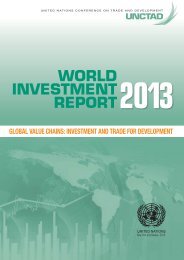


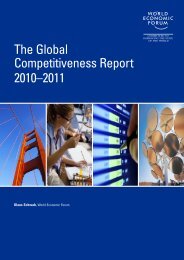
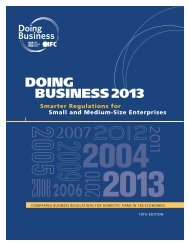


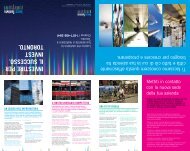
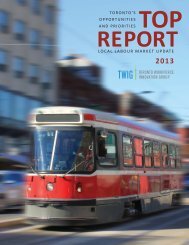


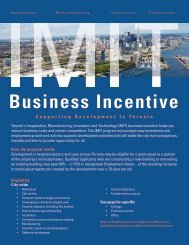
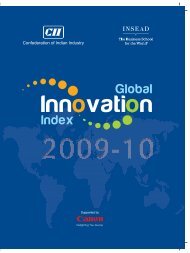
![Creative City Planning Framework [PDF] - City of Toronto](https://img.yumpu.com/24270607/1/190x245/creative-city-planning-framework-pdf-city-of-toronto.jpg?quality=85)